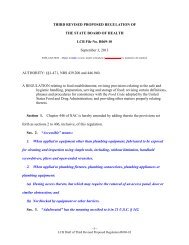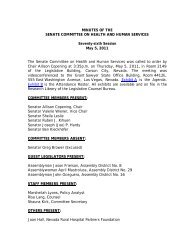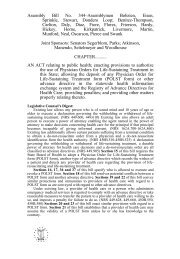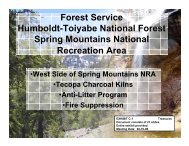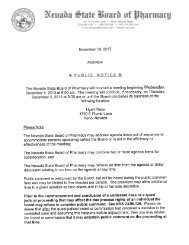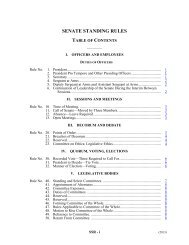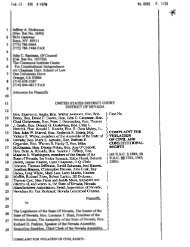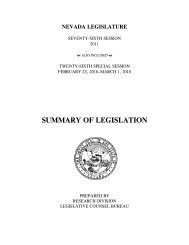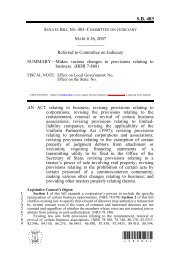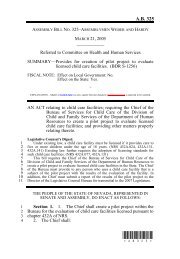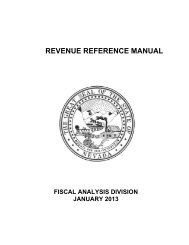Nevada Pre-Kindergarten Standards
Nevada Pre-Kindergarten Standards
Nevada Pre-Kindergarten Standards
Create successful ePaper yourself
Turn your PDF publications into a flip-book with our unique Google optimized e-Paper software.
Content Standard 1.0: Numbers, Number Sense & Computation<br />
Mathematics<br />
Indicator M= Math<br />
1.PK.3a Recognize and read numerals 0-5.<br />
1.K.3 Recognize, read, and write numbers from 0-10.<br />
1.PK.3b Estimate the number of objects in a set of 5<br />
and verify by counting.<br />
1.PK.3c Match the number of objects in a set to the<br />
correct numeral 0 to 5.<br />
1.K.3 Match the number of objects in a set to the correct numeral 0<br />
to 10. Recognize relationships of more than, less than, and equal to.<br />
1.PK.4a Count to 10.<br />
1.PK.4b Count to 10 by demonstrating one to one<br />
correspondence using objects.<br />
1.K.4 Count to 20 by demonstrating one-to-one<br />
correspondence using objects.<br />
1.PK.5 Use concrete objects to combine and separate<br />
groups up to 5.<br />
1.K.5 Use concrete objects to model simple addition<br />
and subtraction.<br />
Content Standard 2.0: Patterns, Functions & Algebra<br />
Indicator M=Math<br />
2.PK.1 Sort objects by similar attributes (e.g., size, shape,<br />
and color).<br />
2.K.1 Identify attributes used to sort objects.<br />
4.K.9 Sort and classify objects by color and shape.<br />
<strong>Pre</strong>-<strong>Kindergarten</strong> <strong>Standards</strong>: Mathematics<br />
Examples: Children will/may...<br />
Identify numbers and match number<br />
symbols 0 to 5.<br />
Compare snack with a friend and<br />
recognize that they have the same amount.<br />
Identify and match the number to a group<br />
of objects.<br />
Identify the next number in a series of<br />
numbers up to 5.<br />
Identify the concepts of “more than, less<br />
than” when comparing two groups of<br />
objects.<br />
Count familiar objects or manipulatives<br />
in the classroom.<br />
Count each object once<br />
(e.g., one-to-one correspondence).<br />
Identify and name numbers in signs<br />
or books.<br />
Put red, yellow, and blue objects<br />
together and count them.<br />
Participate in finger plays, such as “Five<br />
Little Monkeys,” that require counting<br />
backwards.<br />
Examples: Children will/may...<br />
Sort toys by size, color, shape or category.<br />
Match items that are similar (e.g., sort cars from<br />
small trucks).<br />
Match objects such as pictures of adult animals<br />
with their babies.<br />
Give reasons for placement of objects in groups.<br />
Supportive Practice: Practitioner/Adult will…<br />
Consistently provide materials to<br />
promote counting.<br />
Provide children with opportunities to<br />
match object with numbers.<br />
Encourage children to experiment<br />
with counting.<br />
Sing songs that encourage counting.<br />
Model counting of objects.<br />
Provide many opportunities throughout the<br />
day for counting concrete objects.<br />
Ask children to answer the question,<br />
“how many?” in relation to various<br />
concrete objects.<br />
Play counting games.<br />
Read books that feature counting<br />
or numbers.<br />
Model the connection between a counting<br />
word/number and an object.<br />
Supportive Practice: Practitioner/Adult will…<br />
Provide real objects for children to sort, count and<br />
pattern with in the classroom.<br />
Read books to children containing pattern relationships.<br />
Use transitions as a time to incorporate math concepts (sort<br />
children by clothing, gender, eye color, etc.).<br />
23



